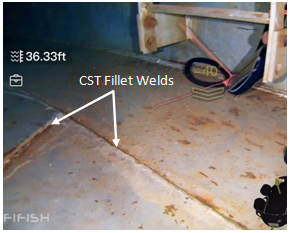Comprehensive Guide to Tank Welding Inspection for Security and Quality
Comprehensive Guide to Tank Welding Inspection for Security and Quality
Blog Article
The Necessary Duty of Storage Tank Welding Assessment in Ensuring Structural Stability and Safety And Security Conformity in Industrial Applications
In the realm of industrial applications, tank welding evaluation arises as a critical component in guarding structural integrity and making certain conformity with safety and security guidelines. Making use of a mix of methods such as visual assessments and advanced screening techniques, these inspections offer to recognize and reduce possible problems before they rise into substantial hazards. The effects of these methods extend past mere governing adherence; they fundamentally impact operational performance and asset long life. Nevertheless, the intricacies surrounding the evaluation process prompt a closer assessment of its techniques and results, disclosing layers of importance that value more expedition.
Significance of Tank Welding Evaluation

Making certain compliance with sector requirements and regulations is an additional substantial facet of storage tank welding inspection. Regulative bodies mandate strict guidelines for the construction and upkeep of tank, and extensive assessments aid organizations follow these requirements. Non-compliance can result in extreme penalties, consisting of fines and closures, even more highlighting the need for rigorous assessment protocols.
In addition, storage tank welding evaluation plays a crucial function in maintaining operational effectiveness. In summary, the significance of tank welding evaluation lies in its capacity to safeguard public wellness, shield the environment, and make sure compliance with regulative structures.
Trick Examination Methods
Reliable storage tank welding examination relies upon a selection of crucial methods that ensure extensive examination of weld top quality and structural honesty. Among the most widespread techniques are visual examination, ultrasonic screening, radiographic screening, and magnetic bit screening - Tank Welding Inspection. Each technique uses one-of-a-kind benefits in analyzing various facets of the weld
Aesthetic evaluation offers as the very first line of protection, permitting assessors to identify surface flaws, irregularities, or inconsistencies in the weld grain. Ultrasonic screening employs high-frequency audio waves to detect internal flaws, such as cracks or gaps, providing a detailed analysis of weld honesty. This technique is specifically efficient in finding issues that may not be visible on the surface area.
Radiographic screening utilizes X-rays or gamma rays to create photos of the welds, disclosing internal gaps and providing an irreversible record for future recommendation. This method is highly effective for crucial applications where the risk of failure should be reduced.
Last but not least, magnetic bit screening is used to recognize surface and near-surface defects in ferromagnetic products. By applying magnetic fields and fine iron bits, inspectors can pinpoint gaps that may endanger the architectural honesty of the tank. With each other, these strategies form a robust structure for making certain top notch welds in commercial applications.
Compliance With Safety And Security Specifications

Normal evaluations play a pivotal function in ensuring compliance by determining prospective failures or inconsistencies from suggested requirements. Examiners are trained to assess weld top quality, verify product specs, and analyze the overall structural article honesty of containers. Their knowledge is essential in guaranteeing that welding procedures fulfill the required safety and security standards.
Moreover, conformity with safety standards not only safeguards workers but additionally safeguards the setting from prospective risks such as leaks or catastrophic failings. Organizations that focus on safety compliance are much better positioned to alleviate risks, improve operational performance, and foster a culture of safety within their labor force. In recap, maintaining strenuous compliance with security criteria is vital for the effective operation of tank welding activities in industrial settings.
Advantages of Normal Evaluations
Regular assessments are important to preserving the structural integrity and security of bonded tanks. These assessments offer an organized approach to recognizing prospective defects or weak points in the welds, guaranteeing that any issues are addressed before they intensify right into substantial failings. By carrying out normal evaluations, companies can find deterioration, fatigue, and other forms of damage that may endanger tank efficiency.
Additionally, regular assessments add to conformity with sector guidelines and criteria. Sticking look these up to these guidelines not only alleviates legal dangers but likewise improves the company's reputation for security and dependability. Routine examinations foster a proactive security culture, motivating employees to recognize and focus on the importance of devices honesty.

Study and Real-World Applications
Situation researches and real-world applications illustrate the tangible impact of efficient tank welding assessment techniques. Complying with the implementation of strenuous welding inspection methods, consisting of visual and ultrasonic testing, the center identified vital problems in weld joints that could have led to tragic failures.
In a similar way, a water treatment plant implemented a thorough inspection program for its storage tank welding operations - Tank Welding Inspection. By including non-destructive testing methods, the plant had the ability to discover very early indications of corrosion and exhaustion in weld joints. This prompt treatment expanded the life expectancy of the containers and guaranteed conformity with safety policies, thus securing public health
These instance studies emphasize the significance of regular and systematic storage tank welding evaluations. By focusing on these techniques, industries can alleviate risks, improve structural stability, and guarantee conformity with safety criteria, eventually bring about enhanced functional performance and minimized obligations.

Conclusion
In conclusion, tank welding inspection is a vital part of maintaining structural integrity and safety in commercial applications. Using numerous assessment techniques makes sure early detection of potential imperfections, consequently protecting against catastrophic failings. Adherence to security standards further boosts operational integrity and compliance with governing needs. Inevitably, routine inspections not only shield public health and the setting yet likewise contribute to the longevity and performance of crucial properties, underscoring the vital function of this technique in commercial operations.
Report this page